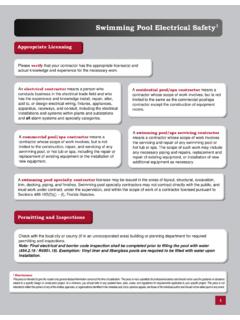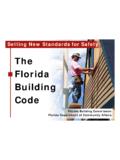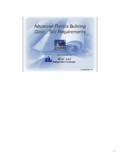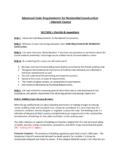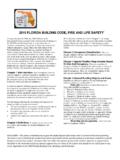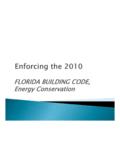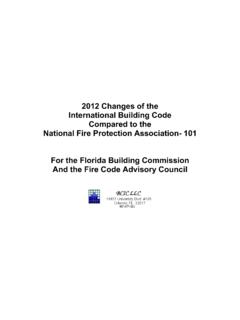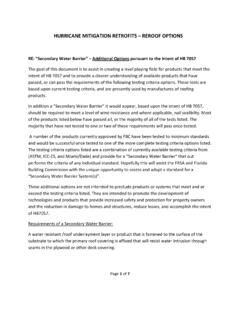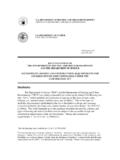Transcription of Florida Accessibility Code for Building Construction
1 1 Florida Accessibility code for Building ConstructionAccessibility Training CourseFlorida Building Commission26/20/032 Introduction Course will review the Florida Accessibility code for Building Construction as contained within the Florida Building CodeInstructor Note: The Florida Accessibility code for Building Construction contains the ADA Accessibility guidelines (ADAAG) and also a number of requirements that are more stringent. These code requirements provide the basis for an accessible built environment in Florida . Without the proper Construction and enforcement of FACBC (Chapter 11 of FBC) requirements, people with disabilities experience exclusion from education, work, transportation, recreation, social interaction and other major life activities that others take for granted. This loss of independence and opportunity are discriminatory in nature. This presentation provides some information that will help you understand how the code benefits the disability community.
2 36/20/033 Agenda Texts Florida Building code (FBC) Chapter 11 Florida Accessibility code for Building Construction (FACBC) Americans with Disabilities Act Accessibility guidelines (ADAAG)Thoroughly explain texts to be used along with how the material will be covered. Instructor will go over each section of the course : 46/20/034 Agenda Overview of Chapter 11 Table of contents Identify problematic areas56/20/035 Overview The Florida Accessibility code for Building Construction (FACBC) Chapter 11 of the Florida Building code (FBC) was certified by the Department of Justice effective October 1, 1997We want you to be aware that Florida has had an Accessibility code since 1974 and it has been updated to the current version that you now see in Chapter 11 of the General terminology Section (FBC) Florida Building code (FBC) FACBC - Florida Accessibility code for Building Construction Chapter 11 of FBC ADAAG Americans with Disabilities Act Accessibility guidelines UFAS Uniform Federal Accessibility StandardsThe vocabulary is very important when addressing accessible facility design, but it is assumed that everyone in class will already have a thorough knowledge of the appropriate vocabulary.
3 Instructor to point out the section and ask the students to go over on their own and email in questions or concerns about the to explain the difference between codes, guidelines and standards. Also, address the issue of accessible design in various states. At present, Florida and several other states have their own Accessibility codes that are certified by the Department of Justice which allows those states to base their review and design of facilities on their codes and not the ADAAG. The key in getting certified is to have a code that is equal to or better than the ADAAG. When Building in various states, counties and areas it is important to know what codes are in force. Discuss the Fair Housing Accessibility guidelines within the FBC, Chapter 11, Part B. Make students aware of the document and the impact on : 10 ANSI , American National Standards Institute guidelines , standards and codes Florida Accessibility code all the highlighted areas within the code are specific to Florida and are not contained within the ADAAG Fair Housing Accessibility guidelines see Chapter 11 FBC, Part B American Society of Mechanical Engineers (ASME)86/20 Minimum Requirements It is important to fully understand scoping requirements before referring to other specific sections of the code implementing its requirementsOne of the most important and overlooked areas of the FACBC is Section Within are the minimum requirements for all areas in Building design.
4 Corresponding to the minimum requirements are the specific requirements within to In many instances people go immediately to the special application section and never look at the minimum requirements : 5 Requirements Application Accessible Site & Exterior Facilities: New Construction Accessible Buildings: New Construction Accessible Buildings: AdditionsQuick overview of sections106/20/0310 Minimum Requirements Accessible Buildings: Alterations Accessible Buildings: Historical Preservation Accessible Buildings, Structures, and Facilities: Architectural Barrier RemovalQuick overview of sections116/20/0311 Section 11-2 General Equivalent Facilitation Departure from particular technical and scoping requirements of this code by the use of other designs and technologies are permitted where the alternative designs and technologies used will provide substantially equivalent or greater access to and usability of the facilityAlternatives to specific requirements that provide equal or greater access are permitted.
5 This provides flexibility for new technologies and innovative design solutions that may not have been taken into account when FBC was of equivalent facilitation: sensor operated lavatory hardware is equivalent to the lever type handles. 126/20/0312 Section 11-2 General Departure from the explicit technical and scoping requirements of this code for any element voids any otherwise applicable presumption of rebuttableevidence that the element has been constructed or altered in accordance with the minimum Accessibility requirements of the ADA Equivalent Facilitation136/20/0313 Section 11-3 Miscellaneous Graphic Conventions ( ) Dimensions that are not marked minimum or maximum are absolute, unless otherwise indicated in the text or captions Dimensional Tolerances ( ) All dimensions are subject to conventional Building industry tolerances for field conditionsFBC recognizes conventional industry tolerances for field conditions.
6 This applies to the field work, not the design work. Information on specific tolerances may be available from industry or trade organizations, code groups, Building officials, and published references. Recommendation: It is good practice to avoid specifying precisely to the maximum or minimum where possible so that achieved dimensions fall within FBC Space Allowance and Reach Ranges Minimum clear width for wheelchair passage (32/36 inches) Forward reach maximums (48 inches high, 15 inches low) changes when obstacles in waySide and forward reach is not always as simple as 54 inches side and 48 inches forward. The exercise presented will get that point what is the maximum height reach range for an object attached to a wall that is immediately over a counter that is 20-25 inches deep? (refer to figures 5a, 5b, 6b, 6c)Answer (44 inches high maximum)Time: 5 - 10 Range166/20/0316 Section Space Allowance and Reach RangesFigure 5a176/20/0317 Section Space Allowance and Reach Ranges Side Reach maximums (54 inches high, 9 inches low)Figure 6b186/20/0318 Reach RangeThe unit on the left does not meet the reach range requirements within or as it is above 54 inches.
7 The unit on the right meets the reach range Accessible Route At least one accessible route within the boundary of the site shall be provided from public transportation stops, accessible parking, and accessible passenger loading zones, and public streets or sidewalks to the accessible entrance they serve Accessible routes shall comply with for head room (80 inches clear minimum)Accessible routes to and from a facility are extremely important. When constructing a facility the design team, contractor and owner need to understand that their responsibility to build a compliant facility does not stop inside the Building but goes beyond that. They are responsible for the outside access as well. In the design, the design team must look at providing an accessible route to and from the bus routes, sidewalks, accessible parking and other facilities. This may mean they have to correct deficiencies in a parking lot or the path of travel from the bus What is the only Florida exception in this section of the FACBC that is not part of the ADAAG?
8 (Hint: Gray box text)Answer ( Exception)Time: 5-10 Protruding Objects Walks, halls, corridors, passageways, aisles, or other circulation spaces shall have 80 inches clear head roomFigure 8aHave the class imagine that they are visually impaired and they are walking along the interior of a facility and have them come up with possible obstructions in their path. Examples fire call boxes, fire extinguisher boxes, hanging signs, In order for a mounted wall object to protrude any amount what is the highest that object can be installed above the walking surface?Answer (27 inches maximum, see & Fig 8a/b)Time: 5 Protruding Objects Objects projecting from walls with their leading edges between 27 inches and 80 inches above finished floor shall protrude no more than 4 inches into walks, halls, corridors, passageways, or aisles226/20/0322 Protruding Object236/20/0323 Protruding Object246/20/0324 Section Protruding ObjectsFigure 8bWalking Perpendicular to a Wall256/20/0325 Section Ground & Floor Surfaces Changes in Level Changes up to inches may be vertical and without edge treatmentFigure 7cAn often overlooked area are door sill treatments.
9 Many details within Building Construction and design rely on what has been used in the past. The problem with that scenario is what has been done in the past may not be correct within the codes. In many areas marble sills are used at restrooms and those sills have an abrupt edge that is greater than inch with no treatment. Complete exercise and ask for other examples of changes in marble sill at restroomReview Section (3) (a) (d) for exceptions to changes in level under alterationsExercise for a restroom sill with an edge that is inches or greater how long would the ramp be?Answer (6 inches minimum, see & )Just because it is a past practice and has been done that way for years doesn t mean it is : 5 Ground & Floor Surfaces Changes between inches and inches shall be beveled with a slope no greater than 1:2 Figure 7d276/20/0327 Section Ground & Floor Surfaces Changes greater than inches shall be accomplished by a ramp that complies with or & Passenger Loading Zones296/20/0329 Section (5) Parking & Passenger Loading Zones Minimum number of spaces 1 to 25 = 1 26 to 50 = 2 51 to 75 = 3 76 to 100 = 4 501 to 1000 2% of total 1001 and over, 20 plus 1 for each 100 over 1000In Florida , all accessible parking spaces are required to be 12 ft wide with an accompanying 5 ft.
10 Access aisle. Also, per the FACBC an accessible path of travel shall be provided from the parking space to the facility being served. Discuss the accessible path of 1100 space lot = 21 Accessible spaces (Disabled = Accessible parking spaces)Exercise What is the required width of an accessible parking space within Florida code ( )? Can spaces share an access aisle ( )?Answers (12 ft. wide plus a 5 ft. access aisle; yes, any two spaces can share a common access aisle)Review photos associated with slide and discuss observations. Review striping design : 5 (5) Parking & Passenger Loading ZonesFigure 9aFigure 9b316/20/0331 Passenger Loading Zone326/20/0332 Parking AreaCompliantParking spaces with 12 x 5 spaces in different applications (straight on and diagonal). Note signs (are they compliant). Also, the blue box and wheelchair on the ground isn t by code , but it is shown here as in most applications it will be present.
